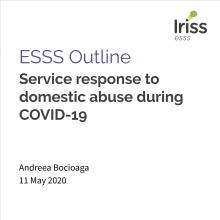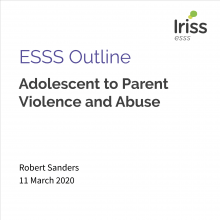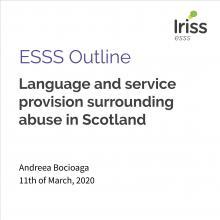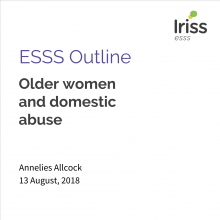Introduction
This evidence summary seeks to address the following questions relating to tackling domestic violence :What is the impact of the Safe and Together model? What changes can it bring locally?
About the evidence presented below
We searched for academic literature and grey literature on the Safe and Together approach. Given the recent development of this approach, the search was restricted to publications since 2015. The majority of the evidence is produced by members of the Safe and Together Institute itself. Below include a range of reports from Scottish Government and the Safe and Together Institute.
Background
In June 2017, Social Work Scotland joined a consortium that seeks to implement the Safe and Together model in Scotland alongside Scottish Women’s Aid, Barnardo’s and the Improvement Service (which hosts the National Violence Against Women Network). In April 2019, the Scottish Parliament passed a new piece of legislation which recognises coercive control as a domestic abuse offence.
Building on these developments, several local authorities are re-evaluating their approach to tackling domestic abuse and improving the support they give to women and children, as well asto perpetrators of domestic abuse. Ten local authorities now use the Safe and Together approach (Scott, 2019).
The Safe and Together model, originally developed in the USA, is a suite of tools and interventions to transform child welfare practice in cases of domestic violence (Humphreys and colleagues, 2017). According to Humphreys and colleagues (2018, p:277) ‘the Safe and Together approach to child welfare provides a robust foundation upon which practitioners from statutory and nonstatutory backgrounds can work collaboratively and reach consensus about how best to ensure the safety and wellbeing of children living with domestic family violence.’ The model has three principles: keeping children with survivor parent/guardian; partnering with surviving parent as a default position; and intervening with abuse perpetrator to reduce risk and harm to children (Safe and Together, 2018). Planning and decisions regarding the child’s wellbeing are informed by five critical components: the perpetrator’s pattern of coercive control; actions taken by the perpetrator; full spectrum of efforts of surviving parent; the adverse impact this has on the child; and the wider role of substance abuse, cultural and other factors (Safe and Together, 2018).
Practice implications of the model are linked with better assessment, better partnerships and better case plans (Scott, 2019; Safe and Together, 2018). The following discusses evidence from a range of sources to consider the evidence on the Safe and Together approach in practice.
Evidence
Improving assessment practice
Humphreys C, Healey L and David Mandel (2018): Case reading as a practice and training intervention in domestic violence and child protection, Australian Social Work, 71, 3, 277-291
The Humphreys’ and colleagues (2018) study investigates how a Safe and Together training tool for case reading can impact the assessment practice of professionals from Child Protection and specialist Domestic Family Violence services in Australia.
A total of 30 experienced professionals worked alongside state-based researchers in a case-reading process. This involved pre-reading resources on Safe and Together, two days of training with David Mandel on the case-reading process, learning to use the templates to review the case files and a two-day case-reading workshop. Professionals worked in pairs to analyse de-identified cases according to a prescribed template built on the principles and critical components of Safe and Together.
The main findings of this study in relation to workplace practice include:
- All participants in this study reflected on how the case reading tool helped them articulate details about the behaviours occurring in the case in a more direct way rather than hide behind euphemisms
- Some professionals felt it enhanced institutional empathy between different organisations
- Some considered the case reading tool a good way to audit internally
- Some felt there were still barriers between policy and practice
- Some professionals were overwhelmed by the emotional labour involved in the new approach
Overall, the process of case-reading was seen as an enabler for improving competencies in risk assessment, case-decision making, complex case planning and cross-system collaboration.
Limitations: The evidence in this study is restricted to case reading data. It is unclear how this affects long-term outcomes and day-to-day practice of social workers.
Safe and Together Overview and evaluation data briefing (PDF) (2018), Safe and Together Institute.
This report outlines the evaluations of the model conducted across several states in the US.
The evidence presented for the state of Ohio was collected as a third-party evaluation of the Safe and Together model by the National Center for Adoption Law and Policy (NCALP), the Healthpath Foundation of Ohio and ODJFS. The evaluation involved: ‘(a) an online pre/posttest survey of 837 CPS caseworkers and supervisors; (b) semi-structured interviews with 16 supervisors; (c) semi-structured interviews with 8 community stakeholders; (d) desk reviews of 191 CPS case files; and (e) review of written policies from 15 counties that had completed Safe and Together training.’ (Safe and Together Institute, 2018, p.4).
The main findings of this report in relation to workforce practices include:
- The evaluation showed significant attitude changes such as less victim blaming
- Practitioners were able to better screen and assess coercive control
- Child welfare services were better at partnering with the adult victims
- Engagement and interviewing with perpetrators became more important
- Overall, those trained in Safe and Together were able to better assess and document the impact of perpetrator’s behaviour on children
For Colorado, the report is based on a survey with 36 supervisors of the Department of Children and Families. The majority of those surveyed reported positive changes in their supervisory practices and their workers practice. Eighteen of these supervisors reported positive changes in outcomes for families. Similar feedback is presented from a number of training events delivered in Colorado.
Limitations: The data presented in these reports is limited to practitioners’ own perspectives of impact, with no further investigation into specific practices and outcomes. Details about how the evaluations were conducted are not provided. It is unclear how this affects long-term outcomes and service users.
Safe and Together Edinburgh Implementation report (PDF) (2018).
The report outlines the findings of two audits. The first audit conducted in 2014 evidences the need for practice change. The second audit was conducted in 2017 following a series of S&P trainings and Practitioners’ Forums.
The following will focus on the findings of the audit which are relevant to S&P impact. The second audit was based on 18 cases allocated to social workers not trained in S&P and 12 cases allocated to social workers who were trained in S&P. The auditing was done by 16 case file readers. Thirteen of the readers had attended a four-day training in S&P practice tools. Similar to Humphrey’s and colleagues (2018), the auditing process was based on comparing the case file to a template and alongside examples of best practice.
The findings of the audit include:
- The quality of assessment rose substantially across those cases where the social workers had been trained in S&P (compared to 2014 when they were not trained)
- However, assessment practice also improved among those social workers who were not trained
- The audit revealed that those social workers who had been through S&P training were able to recognise patterns of abuse and controlling behaviour rather than focus on individual incidents, consider the wide ranging impact on the child, identify the strengths of the survivor and the role of abuse mental health and other factors
- Auditors stated that cases in 2017 detailed clear actions with regards to domestic violence, that each parent was held accountable separately for their engagement and that there were well developed safety plans
- The audit revealed that the numbers of cases in 2017 which put the perpetrator at the centre of interventions had increased among both S&P trained and untrained social workers
- The quality of the child’s plan which met best practice in relation to domestic abuse rose significantly from cases audited in 2014 to cases audited in 2017
Limitations
Some of the reporting, as well as how the outcomes were measured in this auditing process is confusing. The findings are limited to the perspectives of the auditors. It is unclear how the social workers themselves reported changes in their practices or how service users experienced these changes, if at all.
The following section considers the S&P model in relation to outcome changes.
Outcomes impact
Safe and Together Overview and evaluation data briefing (PDF) (2018), Safe and Together Institute.
The following study includes some evidence that considers how Safe and Together could impact outcomes for children and families overall. According to the Safe and Together project site in Northwest Florida, from January 2012 through June 2012, domestic violence related removals represented 20.6% of removals in Bay and Gulf Counties. This was the first six months of the project when the staff was receiving Safe and Together model training. Advocates had also been recently employed. During the next six months, from July 2012 to December 2012, the removal rate further dropped to 13.6%. Between January 2013 to June 2013, the removal rate dropped even more to 9.1%.
The evaluation also reports that an increase in verified domestic violence maltreatments (by almost 60%), combined with a serious decrease in removals (over 50%) and a stable raw number of repeat maltreatments, is expectedas a result of improved child welfare practice and community collaboration.
This correlation is not clearly evidenced, but based on practitioner views and it is unknown whether this is the result of a declining trend over the years.
Safe and Together Institute (n.a.) Domestic violence survivors’ reflections on applying the Safe and Together model in their role as Parent Partners (PDF)
A study done by the Safe and Together Institute offers some perspective of how the model has been perceived by parent partners, survivors of domestic violence who were acting in the role of mentor. This study identifies three outcomes:
- Safe and Together removes a lot of the stigma associated with talking about domestic violence
- Safe and Together makes it easier to recognise the perpetrator’s harmful behaviour, as well as the strengths of the surviving parent
- Parents also felt that domestic abusers were finally being held accountable and accepted to recognise and remedy their behaviour
While this study offers a qualitative insight into how Safe and Together impacts those in cases of domestic violence, the evidence presented is at times speculative. Although it tries to extend the remit of its findings to parents’ perspectives of Safe and Together, those interviewed had not actually experienced a Safe and Together approach in their engagement with child protection services. The parents interviewed were themselves part of support services - mentoring and their perspectives were informed by their Safe and Together training.
Implementation of Safe and Together
The study below considers some of the challenges of implementing Safe and Together in Scotland.
Scott J (2019) Safe and Together Institute for Scotland: Report of scoping activity (PDF)
This report conducts a scoping review of the current experiences of organisations using Safe and Together at operational and strategic level in Scotland. Thirty one interviews were conducted with professionals and organisations involved in child welfare and domestic abuse.
- The findings of the report indicate that staff found it difficult to continue using the Safe and Together approach in practice without the support of managers or supervisors. This was especially challenging if the Safe and Together approach to assessments was questioned in forums like Children’s Hearings or Court.
- This report indicates that implementation was seen as more impactful where specific training had been delivered to team managers and supervisors and when those trained were able to connect regularly and share experiences.
- Local authorities also felt there was a need for a culture change that the Safe and Together approach cannot deliver on its own.
- The study also reports on how Safe and Together provides a consistent language for assessment and report writing among child protection practitioners which allowed staff to challenge the views of others.
This report identifies several challenges of implementing the Safe and Together approach:
- There is a need for critical mass in terms of numbers of staff being trained
- Initial training costs - with small authorities being at a disadvantage
- Continued training need
- Accredited training - some professionals are critical of the business model of Safe and Together which requires accredited local authorities to release staff and funds; individual accreditation has to be renewed and trainers must deliver trainers at least once each year
- Those interviewed felt that the Safe and Together approach needed to be embedded in wider organisational and culture change
Accessing resources
We have provided links to the materials referenced in the summary. Some materials are paywalled, which means they are published in academic journals and are only available with a subscription. Some of these are available through the The Knowledge Network with an NHS Scotland OpenAthens username. The Knowledge Network offers accounts to everyone who helps provide health and social care in Scotland in conjunction with the NHS and Scottish Local Authorities, including many in the third and independent sectors. You can register here. Where resources are identified as ‘available through document delivery’, these have been provided to the original enquirer and may be requested through NHS Scotland’s fetch item service (subject to eligibility).
Where possible we identify where evidence is published open access, which means the author has chosen to publish their work in a way that makes it freely available to the public. Some are identified as author repository copies, manuscripts, or other copies, which means the author has made a version of the otherwise paywalled publication available to the public. Other referenced sources are pdfs and websites that are available publicly.
References
- Humphreys C, Healey L and Mandel D (2018) Case reading as a practice and training intervention in domestic violence and child protection. Australian Social Work, 71, 3, 277–291. https://doi.org/10.1080/0312407X.2017.1413666
- Humphreys C and Nicholson D (2017) Multi-agency triage project. Implementing stage 3 of the multi-agency triage model. Final report. (December).
- Safe and Together Institute (2017) Safe and Together Edinburgh. 1–23.
- Safe and Together Institute (n.d.) Domestic violence survivors’ reflections on applying the Safe and Together model in their role as Parent Partners.
- Safe and Together Institute (2018) Overview and evaluation data briefing. Retrieved from: https://safeandtogetherinstitute.com/wp-content/uploads/2018/04/OverviewEvalDataBriefing_A4_r3.pdf
- Scott J (2019) Safe and Together Institute for Scotland : Report of scoping activity.
Suggested reference: Bocioaga, A (2019) ESSS Outline: Evidence on the Safe and Together approach. Iriss. http://doi.org/10.31583/esss.20191209






